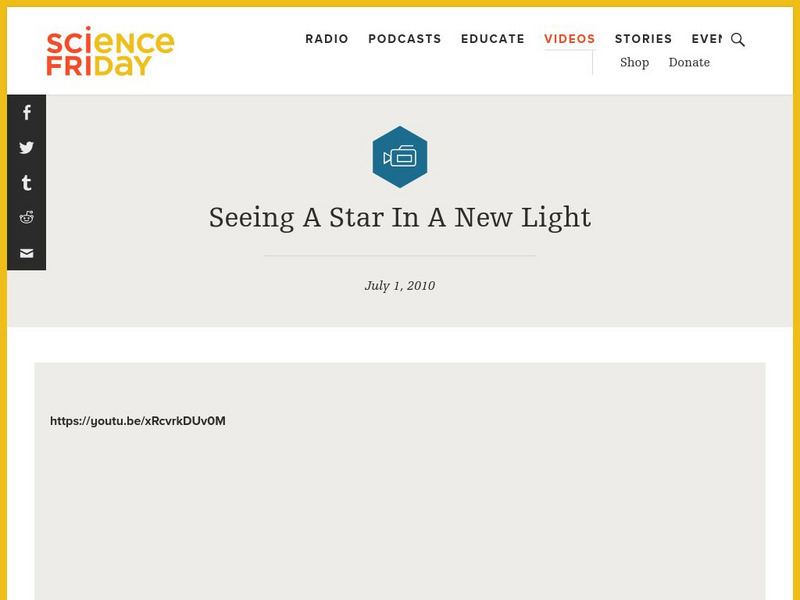SciShow
What Causes Auroras?
SciShow tackles a Quick Question with a longish answer: What causes auroras? TL;DR: It's a breathtaking display of particle physics in action.
SciShow
5 Things We Still Don't Know About the Solar System
We've already learned a lot about the solar system, but sometimes the most fascinating things are what we DON'T know.
Crash Course
The Sun
Phil takes us for a closer (eye safe!) look at the two-octillion ton star that rules our solar system. We look at the sun's core, plasma, magnetic fields, sunspots, solar flares, coronal mass ejections, and what all of that means for our...
NASA
Why Does NASA Observe the Sun in Different Colors?
The Solar Dynamics Observatory, or SDO, spacecraft was launched on Feb. 11, 2010, and began collecting science data a few months later. With two imaging instruments – the Atmospheric Imaging Assembly and the Helioseismic and Magnetic...
NASA
A Total Solar Eclipse Revealed Solar Storms 100 Years Before Satellites
Eclipses set the stage for historic science. NASA is taking advantage of the Aug. 21, 2017 eclipse by funding 11 ground-based scientific studies. As our scientists prepare their experiments for next week, we're looking back to an...
NASA
NASA and ESA Spacecraft Track a Solar Storm Through Space
While we track CMEs with a number of instruments, the sheer size of the solar system means that our observations are limited, and usually taken from a distance. However, scientists have recently used data from ten NASA and ESA spacecraft...
Curated Video
Exploring Solar Winds: The Phenomenon and Impact
Solar winds are super fast, nuclear winds emitted by the sun. Were these winds to reach Earth's surface, they would cause a lot of damage. Find out what makes solar winds so dangerous andwWhat protects Earth from this weather.
PBS
Eclipse Over America | Coronal Mass Ejections from the Sun
The sun's corona, rarely seen from Earth, takes up massive amounts of space many times the size of our planet. Viewers discuss and view how scientists study the corona of the sun. They observe the impact of coronal mass ejections on...
PBS
Solar Space Telescopes
See the sun shine as you've never seen it before! Captivate your class with an activity from NOVA's Sun Lab unit. Viewers learn about the advanced satellite-mounted telescopes NASA uses to monitor the sun at every wavelength of light,...
PBS
Solar Wind and Storms
Does the very thing that is responsible for life on Earth also have a dark side? Space scientists differentiate between sunspots, solar flares, and CMEs in an enlightening activity. The lesson, one of several in a unit presented by NOVA,...
PBS
The Dynamic Sun
Sunspots, solar flares, coronal mass ejections ... why is the sun so stirred up? Scholars watch animations of the interaction between moving plasma and magnetic fields and discuss the sun's behavior. The activity, part of NOVA's sun...
Crash Course
The Sun
Our future literally depends on the sun. The video introduces the sun as a star. It explains the plasma magnetic fields, sunspots, solar flares, coronal mass ejections, and more. It concludes with how we rely on the sun, how we protect...
SciShow
Solar Storms
Did you know our sun has the power to make telegraphs work and cell phones cease to work? Show a video that explains solar storms and their impact on us. It describes what solar storms are, when and why they happen, and the good and...
Be Smart
The Science and Beauty of Auroras
Did you know that Earth is one of three planets that experiences auroras? A video explains what happens when the magnetic sun throws giant balls of plasma at the earth. It includes both the beauty and the damage an aurora can...
Be Smart
The Sun Is A Magnet!
Attract learners to science by studying largest magnet in the galaxy. The video explains why the sun is technically a magnet and how the magnetic fields causes solar storms. It also covers the effects of solar storms on the earth such as...
PBS
Pbs Learning Media: Solar Wind's Effect on Earth
This video segment adapted from NASA describes solar storms and their effects on Earth. Animations of coronal mass ejections and solar cycles help explain what we know, and what we can predict, about solar activity. [4:44]
Science Friday Initiative
Science Friday: Seeing a Star in a New Light
NASA's Solar Dynamics Observatory (SDO), launched in February, has started to send back data. The instruments are giving solar scientists an unprecedented look at the sun, says Dean Pesnell, SDO project scientist. The hope is to better...
Crash Course
Crash Course Astronomy #10: The Sun
Take a closer look at the two-octillion ton star that rules the solar system. Also, look at the sun's core, plasma, magnetic fields, sunspots, solar flares, coronal mass ejections, and what all of that means for Earth.











